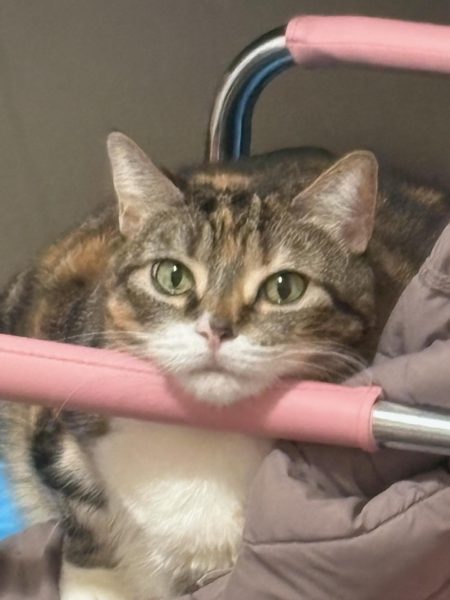The art of fostering: How you can save an animal’s life
56 percent of dogs and 71 percent of cats that enter animal shelters are euthanized. That is an outrageous amount of animals that are being put down because shelters simply don’t have enough space to care for them until they are adopted. This problem could be solved if more people started fostering animals from shelters.
It is really important for people to foster animals from shelters because you can save them from possibly going to a kill shelter. They get a second chance at finding a home and having a good life. It also frees up space in shelters to help more animals.
When fostering an animal from an animal shelter or organization, you are giving the animal a temporary home until they find an adopter. Once an adopter is found, the animal is no longer yours.
A private shelter is usually a non-profit organization that someone has created themselves. They are allowed to create a limit to how many animals they accept. They are not supported by the government. When they turn away animals, they often end up in public shelters.
A public shelter is one that is supported by the government. They are given limited resources but have to accept any animals that are given to them. They are not allowed to say “we are full.” This is dangerous because shelters get overcrowded. Crowded shelters can become unsanitary and some animals that need special attention might not be able to get it.
A kill shelter is where an animal goes when they have been in shelters for too long (and there is no more space) and hasn’t found any adopters or fosterers. They may also go if they are too old, dangerous, or sick. The animals are brought to this shelter to be euthanized.
Jennie Anne Simson works for Brooklyn Animals action, an organization that focuses on cats and is entirely foster-based. Simson discusses her thoughts on kill shelters: “they are not doing it for fun, that’s the way the system is set up that they have to take in every animal and they have a finite number of space.” So kill shelters get a lot of hate, but really they have no choice.
Even if there was always enough space in shelters, according to Simson, “[shelters, and rescuers]are not able to give [foster pets] the whole experience of being in a home with a family and sleeping in a bed and living a regular life while they are waiting to get adopted.” This experience is something that animals can only get from a foster parent.
Mr. Whittaker is not only a teacher at NYC iSchool, but also a proud dog owner. He rescued his dog, Charlie, from a shelter in the south.
“[Charlie] needed a home,” says Mr. Whittaker. It’s as simple as that. There are “infinite amounts of dogs that need homes,” and fostering is an important part of getting them there.
Working with shelters can be “very challenging,” according to Mr. Whittaker. He says that it was hard to get a dog from a shelter because they are very reluctant to give pets out to just anyone. This was surprising to Mr. Whittaker since he thought that they would be “just handing these dogs out” since shelters can be overcrowded.
The reason that shelters are not doing this is that often, people will rescue a pet thinking that they are able to handle the responsibilities, but later realize that they cannot and have to return the animal to the shelter. This puts shelters in a very difficult situation because they most likely don’t have space and those animals end up getting euthanized.
Flo Vagnetti has 3 adopted cats from shelters: Isabel, Tilly, and Aurora. She also fostered 2 kittens this past summer. Their names were Ellis and Baldwin. After doing it once, she already knows that she wants to do it again.
Flo says that she got “pretty attached to them¨, but that saying goodbye was not too difficult because the kittens were adopted by her mom’s friends who also happens to be a vet. Flo says that she “knew they were in good hands.”
There are many misconceptions about fostering that cause people to decide against it. Like Mr. Whittaker, many worry that they will get too attached to the animal. It is reasonable that someone who loves animals would not want to let them go, but it is important to remember that saying goodbye frees up space for you to keep fostering!
Coco Park Animal Hospital discusses this issue in the Facts About Fostering section when they say, “Some people don’t foster sick or older animals because they would be too sad if the animal died. For others, the attachment to the particular animal becomes so strong that one wants to adopt the fostered animal.¨
Another misconception is that shelter animals are less socialized, sick, dirty, and overall “less quality” than bred ones. No matter how harsh this sounds, part of it is true. Animals in shelters have likely been strays living on the street before and are more likely to have certain illnesses or infections, but this doesn’t make them any worse of a companion.
Simson says that her organization “[tries] to match people to cats that will be a good fit in that foster home,” so if you can’t handle high-maintenance, sick, or less socialized animals, then you probably won’t end up with one.
It also isn’t just rescue animals that have problems, bred animals have a lot of issues of their own. Simson explains, “[purebreds] have genetic issues that are not present in the general cat population.”
Another misconception is that people think that it is a huge commitment, but really you can foster an animal for only 2 weeks if that is the only time you have available. Simson says, “The stakes are super low for the humans like the commitment is super flexible “. Many foster animals will have multiple foster parents before getting adopted. This isn’t ideal, but it is much better than not getting fostered at all.
People also think that to foster you need to have a lot of experience, but according to Jennie, “all you need to be able to foster is a space to put a cat and the willingness to take care of them”. She also uncovers the misunderstanding that fostering is too expensive. Most organizations will, “cover the cost of vetting”.
According to Flo, the most difficult part about fostering kittens was that they were so vulnerable. Her main concern was keeping them healthy, she says that “they had, like, fevers and we had to keep track of their weight”, but in the end, it was all worth it.
One more concern that people have is that they already have a pet and don’t know what the adjustment will be for that pet. Flo says that her foster cats and adopted cats “did not come in contact”. The kittens were in a playpen. Apparently, Isabel didn’t like the kittens, but Tilly and Aurora didn’t care. As you can see, the cats were all okay. If possible, you can introduce any pet you have to the foster pet before you commit.
Coco Park Animal Hospital explains that fostering doesn’t just mean watching animals from a shelter. For experienced foster parents or animal rescuers, it can also mean ¨caring for a litter of kittens until they are weaned, treating an injured animal until healed, or caring for a terminally ill dog until his quality of life is no longer good.¨
Fostering is also a great option if you are considering adoption but not sure if you are ready. You can think about it as a trial run. Many people don’t want to commit to having to take care of an animal for their whole lives so fostering is a great alternative.
The Top 5 Reasons to Foster an Animal in Need from the ASPC says, ¨it’s a win, win!¨ because ¨Animals in your care can go on to loving homes and animal shelters have more space and resources to help even more animals in need.¨







